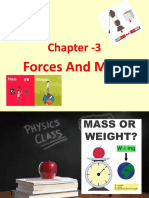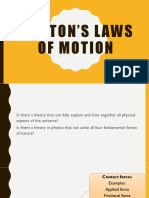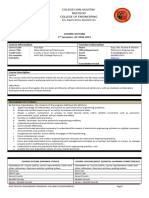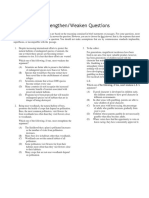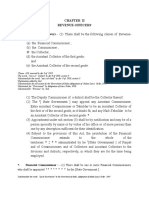0 ratings0% found this document useful (0 votes)
154 viewsNewtons Law
Newtons Law
Uploaded by
Cindelle Mariae GomiegaThe document discusses different types of contact and non-contact forces including tension, normal force, friction, spring force, thrust, gravitational force, magnetic force, and electrical force. Examples and definitions are provided for many of these forces.
Copyright:
© All Rights Reserved
Available Formats
Download as PPTX, PDF, TXT or read online from Scribd
Newtons Law
Newtons Law
Uploaded by
Cindelle Mariae Gomiega0 ratings0% found this document useful (0 votes)
154 views31 pagesThe document discusses different types of contact and non-contact forces including tension, normal force, friction, spring force, thrust, gravitational force, magnetic force, and electrical force. Examples and definitions are provided for many of these forces.
Original Title
NEWTONS LAW
Copyright
© © All Rights Reserved
Available Formats
PPTX, PDF, TXT or read online from Scribd
Share this document
Did you find this document useful?
Is this content inappropriate?
The document discusses different types of contact and non-contact forces including tension, normal force, friction, spring force, thrust, gravitational force, magnetic force, and electrical force. Examples and definitions are provided for many of these forces.
Copyright:
© All Rights Reserved
Available Formats
Download as PPTX, PDF, TXT or read online from Scribd
Download as pptx, pdf, or txt
0 ratings0% found this document useful (0 votes)
154 views31 pagesNewtons Law
Newtons Law
Uploaded by
Cindelle Mariae GomiegaThe document discusses different types of contact and non-contact forces including tension, normal force, friction, spring force, thrust, gravitational force, magnetic force, and electrical force. Examples and definitions are provided for many of these forces.
Copyright:
© All Rights Reserved
Available Formats
Download as PPTX, PDF, TXT or read online from Scribd
Download as pptx, pdf, or txt
You are on page 1of 31
Contact Force
- The bodies are in direct
contact.
Noncontact Force
- Force that acts even if
interacting bodies separated
Contact Force
1. Tension
Described as the pulling
force transmitted
axially by the means of
a string, a cable, chain,
or similar one-
dimensional
continuous object.
Contact Force
2. Normal Force
It is a contact force by a surface on
an object. Its direction is
perpendicular but away from the
surface.
Contact Force
3. Kinetic and Static Friction
Friction (Ff), This
contact force
acts to oppose
sliding motion
between
surfaces.
Contact Force
4. Spring Force
It is a contact force
which is either a pull
or a push exerted on
an object by a spring.
Contact Force
5. Thrust
This contact force is
the general term for
the forces that
move objects such
as rockets, airplanes
cars and people.
Contact Force
- The bodies are in direct
contact.
Noncontact Force
- Force that acts even if
interacting bodies separated
Contact Force
1. Gravitational Force
Gravitational force is an attractive
force. This is the non-contact force
between two bodies in the universe
due to the gravitational attraction
between them.
Contact Force
1. Gravitational Force
Contact Force
2. Magnetic Force
Contact Force
3. Electrical Force
This acts
between
objects that
are electrically
charge.
A painting of Sir Isaac Newton by Sir Godfrey Kneller (1689)
INERTIAL
REFERANCE FRAME
• A frame of reference where
Newton’s first law of motion
holds.
• It is the viewpoint of the
observer of motion.
"A body at rest will remain at
rest, and a body in motion will
remain in motion unless it is
acted upon by an external force."
-It is the property of a body
that tends to resist change in
its of motion.
-Mass is the measure of
inertia.
"The force acting on an object
is equal to the mass of that
object times its acceleration.“
F = ma
Unit of Force : N or dyne
1N = 1 kg m/s²
1dyne = 1 g cm/s²
1N = 10⁵ dynes
F = ma
∑F× = ma× ∑Fz = maz
∑Fy = may
Sample Problem
A 3kg block is acted upon by a force
F=(3.0î+4.0ĵ) N.
a. Find the magnitude of the
horizontal and vertical
components of acceleration of the
block.
b. Find the magnitude and direction
of the acceleration of the block
Sample Problem
a. ax = Fx / m
y ay = Fy / m
ĵ b. a = √ ax² + ay²
î
k̂ x
θ= tan ̄¹ ay/ax
z
Sample Problem
An astronaut weighs 931N here on earth.
a. What is his mass on Earth?
b. What is his mass on the surface of the
moon?
c. What is his weight on the surface of the
moon?
( Hint: The acceleration due to gravity on the
surface of the moon is 1.62 m/s² )
Sample Problem
The acceleration due to gravity on the
surface of Jupiter is 254% times that of
Earth. An object has a mass of 55kg here
on Earth. What will be its weight at the
surface of Jupiter?
"For every action, there is an
equal and opposite
reaction."
Action-reaction pair
- Action and reaction forces are equal in
magnitude but opposite in direction and
are assigned arbitrarily.
Sample Problem
At a roller skating rink, a girl pushes a boy,
causing a boy to accelerate at 1.5 m/s² to
the right. The masses of the boy and the
girl are 60kg and 50kg, respectively.
a. Find the force exerted by the girl on the
boy.
b. Find the force exerted by the boy on the
girl.
c. Find the acceleration of the girl.
Sample Problem
Mickey and Kyle of masses 35kg and 55kg,
respectively, are standing on a very
slippery icy surface. Kyle pushes Mickey
to the left with a force of 75N.
a. Find the acceleration of Mickey.
b. The force that Mickey exerts on Kyle.
c. Acceleration of Kyle.
FREE BODY DIAGRAM
- Is a physical model of an
object that is affected by
several forces both contact
and non contact forces.
NET FORCE
- It is the sum of all the forces
acting on the body.
Example
• A cable is lifting a crate. The speed of the
crate is increasing. How are the forces on
the crate related to the change in speed?
Forces acting on the crate are Fg & FT.
Fg – weight of the crate
FT – Tension on the cable
a – acceleration (going up)
FT + (- Fg ) = Fnet
Fnet = ma
a = ∆v / ∆t
Exercise
DRAW A FREE-BODY DIAGRAM
• 1. A rope pulls a box at constant speed across
a horizontal surface where there is friction.
• 2. A rope pulls a bucket upward at constant
speed. (ignore air resistance)
• 3. A skydiver jumps and falls downward
through the air at constant velocity. (air
resistance is important)
• 4. A book on a desk
You might also like
- Children in Room E4 DiscussionDocument16 pagesChildren in Room E4 Discussionapi-384774890100% (3)
- Penis Owner's Instruction ManualDocument11 pagesPenis Owner's Instruction Manualkohsija92% (60)
- A History of Irish Theatre - : Christopher MorashDocument26 pagesA History of Irish Theatre - : Christopher MorashBianca PintoNo ratings yet
- 3 - DynamicsDocument2 pages3 - DynamicsStephen CamsolNo ratings yet
- Chapter 2:forceDocument74 pagesChapter 2:forceTing CheongNo ratings yet
- Forces: Free Body DiagramsDocument45 pagesForces: Free Body DiagramsAsad SamiNo ratings yet
- 4.2 Newtonian MechanicsDocument28 pages4.2 Newtonian Mechanicsjeevith.k2053No ratings yet
- Types of ForcesDocument7 pagesTypes of Forcesimanuelsukarno0% (1)
- Physics Lesson Note for Grade 9 (2)Document12 pagesPhysics Lesson Note for Grade 9 (2)robelbereket2027No ratings yet
- Force N MotionDocument45 pagesForce N MotionSapari VelNo ratings yet
- Free-Body Diagrams PDFDocument33 pagesFree-Body Diagrams PDFRITUPARNA BISWASNo ratings yet
- Reviewer-in-ScienceDocument6 pagesReviewer-in-ScienceHaruto AmorNo ratings yet
- Newtons 2nd Law Lesson 3Document19 pagesNewtons 2nd Law Lesson 3Aimee Gallego AngoluanNo ratings yet
- ch3 - 1d DynamicsDocument17 pagesch3 - 1d Dynamicsapi-301275445No ratings yet
- L1: Forces NotesDocument46 pagesL1: Forces NotespersoneamistoseNo ratings yet
- 3 - Force and Newton's LawsDocument45 pages3 - Force and Newton's LawsShivaranjini RamendranNo ratings yet
- namma_kalvi_10th_science_june_month_syllabus_study_material_emDocument67 pagesnamma_kalvi_10th_science_june_month_syllabus_study_material_emsubikshan182006No ratings yet
- BahanKuliah 2BDocument74 pagesBahanKuliah 2BAsep RNo ratings yet
- Physics Key Terms and Meaning-Semester-1Document6 pagesPhysics Key Terms and Meaning-Semester-1techzealNo ratings yet
- Week 6 Chapter 5Document56 pagesWeek 6 Chapter 5Asnan AzeemNo ratings yet
- LN ForcesDocument3 pagesLN ForcesNaomi Tabudlong PaylagaNo ratings yet
- Law of MotionDocument76 pagesLaw of MotionLove With Books 2470% (1)
- Chapter - 3: Forces and MotionDocument88 pagesChapter - 3: Forces and MotionAlisha QaziNo ratings yet
- Force & FrictionDocument53 pagesForce & FrictionJerald MagcalasNo ratings yet
- Chap 4Document50 pagesChap 4Saeed ullahNo ratings yet
- AP Physics Motion & Force DynamicsDocument12 pagesAP Physics Motion & Force DynamicspuvalaiNo ratings yet
- p6 Final Lecture1Document7 pagesp6 Final Lecture1Rona CabuguasonNo ratings yet
- Lec 3 GDocument31 pagesLec 3 GThắng NguyễnNo ratings yet
- Forces and MotionDocument37 pagesForces and MotionpjpanisNo ratings yet
- Chapter 4: ForcesDocument57 pagesChapter 4: ForcesvisarbaxhukuNo ratings yet
- Newton LawsDocument38 pagesNewton LawsaliroomanqNo ratings yet
- AFCAT GK General ScienceDocument53 pagesAFCAT GK General Sciencerustam1rioNo ratings yet
- UNIT 1. The First and Second Law of Motion STUDENTSDocument32 pagesUNIT 1. The First and Second Law of Motion STUDENTSMarcella AnnaNo ratings yet
- Chapter - Force and Newton's Laws-FinalDocument52 pagesChapter - Force and Newton's Laws-Finalraie saadNo ratings yet
- Frame of WorksDocument59 pagesFrame of WorksangelencavillarezNo ratings yet
- Newtons LawsDocument70 pagesNewtons Lawselma gagarinNo ratings yet
- Newtons - Laws Grade 8Document70 pagesNewtons - Laws Grade 8Jillian jan HamoyNo ratings yet
- 2 Force and AccelerationDocument22 pages2 Force and AccelerationMohd Harris IdrisNo ratings yet
- Newton'S Laws of MotionDocument49 pagesNewton'S Laws of Motionbae joohyunNo ratings yet
- Force Gravity Weight Friction 1Document17 pagesForce Gravity Weight Friction 1faiyazlegit77No ratings yet
- PhysicsDocument5 pagesPhysicssu thadahtetNo ratings yet
- Laws of Motion Icse Class 9Document12 pagesLaws of Motion Icse Class 9aaravyaduvanshi0904No ratings yet
- EebodydiagramDocument41 pagesEebodydiagramTechhhniniNo ratings yet
- Chapter 4 Lec NewtonDocument40 pagesChapter 4 Lec Newtonsmcm11No ratings yet
- Chapter 4Document74 pagesChapter 4Melody Mae O. Damole43% (7)
- LawsDocument63 pagesLawsJonathan Libo-onNo ratings yet
- PhysicsDocument53 pagesPhysicsIwana Rademaekers100% (1)
- 2Q PhysicsDocument7 pages2Q Physicslhiabulaybulay119No ratings yet
- Lesson 1 - Laws of MotionDocument66 pagesLesson 1 - Laws of MotionGianina De LeonNo ratings yet
- Chapter 3 DynamicsDocument5 pagesChapter 3 DynamicsLakhan VaishnavNo ratings yet
- PHY 101 Quiz #16 SolutionsDocument8 pagesPHY 101 Quiz #16 SolutionsKhalila Khalisha0% (1)
- Lesson 1 General Physics 2 SLM EditedDocument7 pagesLesson 1 General Physics 2 SLM EditedDIANNE PLANANo ratings yet
- 2.1 Force and Motion: Source of ThrustDocument16 pages2.1 Force and Motion: Source of ThrustHong-ming KuNo ratings yet
- Physics Newton'sLawsofMotionDocument44 pagesPhysics Newton'sLawsofMotionCamela LacsamaNo ratings yet
- PS Notes ForceSDocument12 pagesPS Notes ForceScoryguntherNo ratings yet
- Chapter 4 Newton's Laws of MotionDocument5 pagesChapter 4 Newton's Laws of Motionajaysahu1441No ratings yet
- Unit 5. Forces: 1. Forces and Their Effects 2. Simple Machines 3. Types of Forces 4. Common ForcesDocument31 pagesUnit 5. Forces: 1. Forces and Their Effects 2. Simple Machines 3. Types of Forces 4. Common ForcesgenusxyzNo ratings yet
- Newton's Laws of Motion by JoyDocument49 pagesNewton's Laws of Motion by JoyMjoyTibayNo ratings yet
- CHAPTER 7 - Newtons Laws of MotionDocument47 pagesCHAPTER 7 - Newtons Laws of Motionoman92870164No ratings yet
- SHS Laws of MotionDocument80 pagesSHS Laws of MotionMicah Denise Dela PeñaNo ratings yet
- Gravitation and FloatingDocument13 pagesGravitation and FloatingHappy HomeNo ratings yet
- Q1 Lesson 7 Gen PhysicsDocument50 pagesQ1 Lesson 7 Gen PhysicsMaykell Ryan MontejoNo ratings yet
- Fabric Dyeing With Natural Dye Extracted From Basella Alba Fruit and Spectroscopic Analysis of The Extract at DifferentDocument8 pagesFabric Dyeing With Natural Dye Extracted From Basella Alba Fruit and Spectroscopic Analysis of The Extract at DifferentCindelle Mariae GomiegaNo ratings yet
- 001.sugarcane and Cane PreparationDocument60 pages001.sugarcane and Cane PreparationCindelle Mariae GomiegaNo ratings yet
- 002 MillingDocument29 pages002 MillingCindelle Mariae GomiegaNo ratings yet
- AES 301E Basic Electrical and Electronics 2020 2021Document2 pagesAES 301E Basic Electrical and Electronics 2020 2021Cindelle Mariae GomiegaNo ratings yet
- Spiral of Silence TheoryDocument18 pagesSpiral of Silence TheoryAldo HanNo ratings yet
- Strengthen Weaken Mastery PracticeDocument97 pagesStrengthen Weaken Mastery PracticeDheeraj SinghNo ratings yet
- Revenue-Officers 6. Classes and Powers - (1) There Shall Be The Following Classes of RevenueDocument16 pagesRevenue-Officers 6. Classes and Powers - (1) There Shall Be The Following Classes of RevenueZaida ParcoNo ratings yet
- Talking About A New ProjectDocument4 pagesTalking About A New ProjectAngela AlqueroNo ratings yet
- Ahmedabad Rajkot: 5:30 AM 10:00 AMDocument3 pagesAhmedabad Rajkot: 5:30 AM 10:00 AMpunamNo ratings yet
- 1 49Document165 pages1 49Toast MgeeNo ratings yet
- Module 3 Nursing Skills Procedure On GI, Endo-Metab Concept (A)Document18 pagesModule 3 Nursing Skills Procedure On GI, Endo-Metab Concept (A)Nashebah A. BatuganNo ratings yet
- English Grammar Diagnostic TestDocument3 pagesEnglish Grammar Diagnostic TestMikhail MontanoNo ratings yet
- 1st Periodical Test - Values 4Document5 pages1st Periodical Test - Values 4Annie LynNo ratings yet
- Instructional System Design (ISD) : Using The ADDIE ModelDocument2 pagesInstructional System Design (ISD) : Using The ADDIE ModelFitrah PantoliNo ratings yet
- Going Pro 5 Exam 2Document2 pagesGoing Pro 5 Exam 21mcqballesterosNo ratings yet
- Shaw Bible Reading ScheduleDocument2 pagesShaw Bible Reading ScheduleBenjamin ShawNo ratings yet
- How Are Things?: Real Listening and Speaking 3 by Miles CravenDocument16 pagesHow Are Things?: Real Listening and Speaking 3 by Miles CravenkadpoortNo ratings yet
- Simple Past + ExplanationDocument1 pageSimple Past + ExplanationRandall Domingo Alvarado NavarroNo ratings yet
- Complete Work ImmersionDocument49 pagesComplete Work ImmersionMarielle RumbaoaNo ratings yet
- How To Motivate EmployeesDocument13 pagesHow To Motivate EmployeesUsmän MïrżäNo ratings yet
- DSO Marketing Plan v8Document60 pagesDSO Marketing Plan v8jointariqaslamNo ratings yet
- Comparative Analysis of USA and IndiaDocument4 pagesComparative Analysis of USA and IndiaAnkita PatelNo ratings yet
- Psycho-Educational Assessment ReportDocument6 pagesPsycho-Educational Assessment ReportMarvellous MunhuwaNo ratings yet
- Criminal Complaint Using Agencies and Statutes WADocument2 pagesCriminal Complaint Using Agencies and Statutes WAPublic Knowledge75% (4)
- Cost Estimation: Mcgraw-Hill/IrwinDocument17 pagesCost Estimation: Mcgraw-Hill/IrwinAtef RagabNo ratings yet
- Hudson, R.Y. 1974. "Concrete Armor Units For Protection Against WaveDocument89 pagesHudson, R.Y. 1974. "Concrete Armor Units For Protection Against Waveishtiaque_anwar100% (1)
- NMK10603 - Chapter 4 - Functions - Part 2Document22 pagesNMK10603 - Chapter 4 - Functions - Part 2MOHAMMAD SAAID SHARUZQIE BIN SAARI STUDENTNo ratings yet
- 7 FestivalsDocument2 pages7 FestivalsDurai RajNo ratings yet
- ENGL3026 Assessment 1 QuestionsDocument2 pagesENGL3026 Assessment 1 Questionsimane EddarhamiNo ratings yet
- Professional AdjustmentDocument10 pagesProfessional AdjustmentJayson V Caranto RNNo ratings yet
- UntitledDocument16 pagesUntitledelle elleNo ratings yet






















